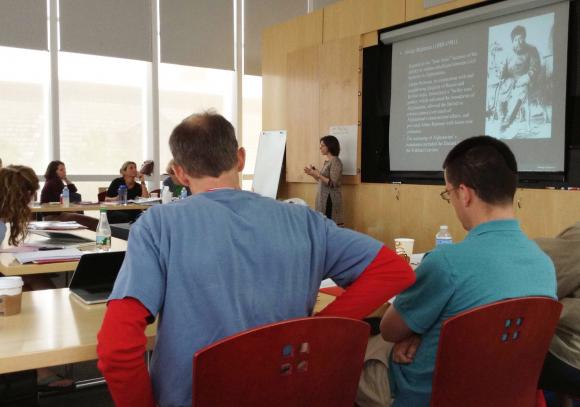PROVIDENCE, R.I. [Brown University] — Nearly 50 high school teachers from around the country have been on campus in recent weeks to take part in two summer institutes hosted by the Choices for the 21st Century Education Program, a program of Brown’s Watson Institute for International Studies and Office of Continuing Education that develops high school-level curricula on historical and current international issues. Since its inception more than 20 years ago, the Choices Program has brought teachers to Brown each summer for a leadership institute. This year, for the first time, Choices also held an institute focused on geography. Both institutes took place at Brown’s Watson Institute for International Studies.
The goal of the Choices institutes is three-fold, according to Susan Graseck, Choices Program director. In attending the institute, teachers get the opportunity to hear from and interact with scholars who are experts in the field, while also exploring new teaching methods and innovative ways to use the Choices Program curricula. Attendees also get the opportunity to meet colleagues from other parts of the country for learning and networking. “That’s a resource in itself,” Graseck said.
Kristine Frailing, a comparative government and economics teacher for Broward County Public Schools in Florida, one of the largest districts in the country, attended the leadership institute, agrees. “I got more out of the institute than I even expected. In addition to the materials I’ll bring back with me, connecting with new people and learning about resources that other teachers use was very valuable.”
Designated as “Choices Teaching Fellows” once they attend an institute, the teachers are expected to complete a self-designed action plan, where they share what they learn with colleagues. Often, according to Graseck, these take the form of leading workshops on Choices curriculum units or sharing information about the program with a professional learning community. Frailing said she plans to conduct professional development workshops for teachers in Florida in an effort to expand comparative government classes in the state.
“It’s outreach that involves building leadership and sending those leaders out to various parts of the country,” Graseck said. “What we’ve found over the years is that the best people to work with teachers new to Choices are teachers already using our materials.”
This year, for the first time, the Choices Program offered two Institutes: a leadership institute on the 1960s for history teachers and one on Afghanistan for geography teachers. This year’s leadership institute was centered around two Choices units: Freedom Now: The Civil Rights Movement in Mississippi and The Limits of Power: The United States in Vietnam. Twenty-three teachers heard speakers from the Brown faculty, including Francoise Hamlin, James Patterson, and Elizabeth Taylor, as well as visiting scholars Charles Cobb Jr. and Judy Richardson, and former Watson faculty James Blight and janet Lang.
Mixed in among the speakers were several sessions on pedagogy, with topics that ranged from creative ways to use the Choices curricula in the classroom to how to integrate Choices into the national Common Core standards.
This year’s addition, the geography institute, featured the Choices unit The United States in Afghanistan. Graseck said the creation of this new institute, which was attended by 25 geography teachers, was a way to highlight the geographic content within the various Choices curricula. “We have a lot of geography content within our materials, but we’ve never organized our resources specifically around geographic content. Geography is a growing area in schools and we were seeing a need.”
The three-day institute included lectures by Seth Dixon, Rhode Island College geography professor and Rhode Island Geographic Alliance coordinator, Jennifer Fluri, a geographer from Dartmouth College, and Brian Williams, professor of history at UMass–Dartmouth. Sean Connors from the National Geographic Society also demonstrated ways to enhance geography teaching. Like the leadership institute, other sessions focused on ways to integrate the Choices Program into the classroom.
Adalia Davis, a human geography teacher in Richmond, Texas, said the lessons on deliberative discussion, a teaching method that pushes students to think critically about issues, were most helpful and that she’ll be integrating those, as well as the Choices units on South Africa and Zimbabwe, areas of particular interest to her students.
“The students are always asking me lots of questions about sub-Saharan Africa and the events that take place in that region. I can answer those questions for them, but now I can see them going through the Choices role-playing exercises and formulating a lot of those answers themselves.”

